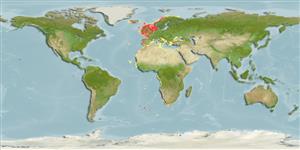Common names from other countries
Classification / Names / Names
Nomi Comuni | Sinonimi | Catalog of Fishes (gen., sp.) | ITIS | CoL | WoRMS
Environment: milieu / climate zone / depth range / distribution range
Ecologia
; salmastro; distribuzione batimetrica 0 - 200 m (Ref. 435), usually 6 - 40 m (Ref. 435). Temperate, preferred 12°C (Ref. 107945)
Eastern Atlantic and the Mediterranean: from northwest Morocco to Atlantic coast of Europe.
Length at first maturity / Size / Peso / Age
Maturity: Lm 11.0 range ? - ? cm Max length : 20.0 cm CL maschio/sesso non determinato; (Ref. 435)
This is the most important edible crab fishery in Europe (Ref. 2762). Maximum depth from Ref. 106870. Occurs from the intertidal area to a depth of 100 m, common at depths 6 to 40 m (Ref. 435). Regularly found just above low tide mark. Found in an estuary (Ref. 106870). Inhabits rocky or sandy bottom (Ref. 96377). Carnivore; trophic level 3.1 (Ref. 96418).
Members of the order Decapoda are mostly gonochoric. Mating behavior: Precopulatory courtship ritual is common (through olfactory and tactile cues); usually indirect sperm transfer.
Fischer, W., G. Bianchi and W.B. Scott (eds.). 1981. (Ref. 435)
IUCN Red List Status (Ref. 130435)
CITES status (Ref. 108899)
Not Evaluated
Not Evaluated
Human uses
Pesca: commerciale
FAO - pesca: landings, species profile | FishSource | Sea Around Us
Strumenti
Fonti Internet
Estimates based on models
Preferred temperature
(Ref.
115969): 8.1 - 12.5, mean 10.4 (based on 518 cells).
Resilienza
Alto, tempo minimo di raddoppiamento della popolazione meno di 15 mesi (K=0.24-0.46).
Prior r = 0.46, 95% CL = 0.31 - 0.69, Based on 2 data-limited stock assessments.
Vulnerability
Low vulnerability (10 of 100).
